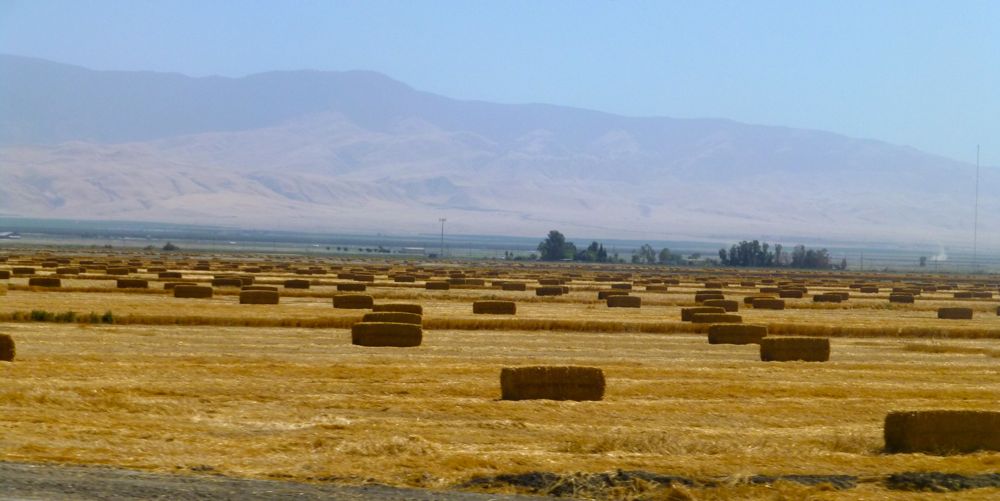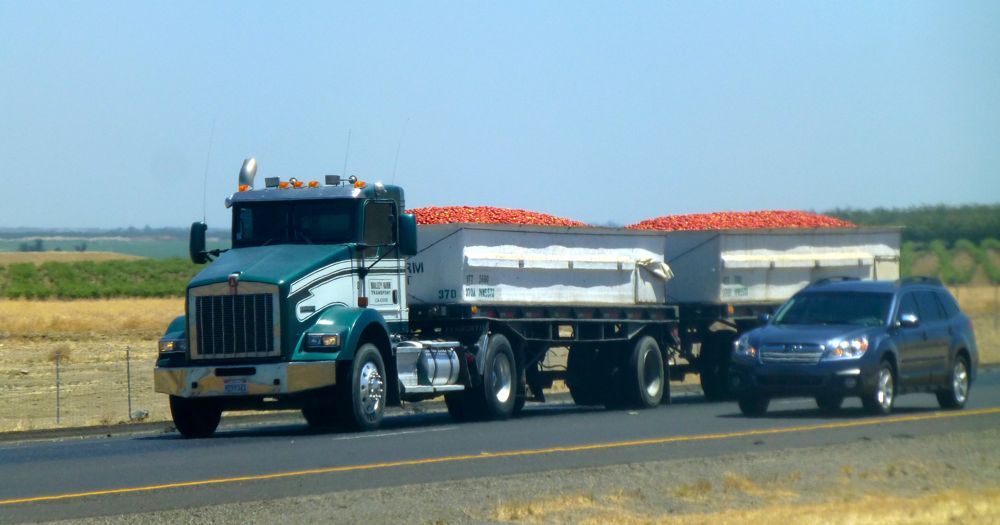Driving south down California’s Interstate ‘5’, from San Francisco to Los Angeles, any time between mid July to mid September, you cannot fail to notice the caravan of northbound trucks hauling tomatoes in huge, white, open pallets. Where are they coming from and where are they headed? Why are the tomatoes not all carefully tissue wrapped in boxes, instead of being piled high and exposed to the elements? How do the not get ruined, especially the ones at the bottom which surely must be ground to a pulp? I decided to do some research and was astounded at what I discovered.
Central Valley produce and tomatoes!
Interstate ‘5’, winds its way through California’s Central Valley, an abundant crop growing area, this much I knew but I never realized just the extent of this abundance. The Central Valley grows about 50% of America’ s fruit and nuts in addition to wheat, cotton and other crops. But the tomatoes!
 13 million tones of tomatoes are grown here every year; it is a business worth about $1.5 billion annually! California produces between 90-95% of the processing tomatoes used in the United States and 1/3 of the world’s processed tomato products. During the summer a steady stream of trucks transport tomatoes north on Interstate ‘5’, from areas like Yolo county, to plants close to Modesto, Lodi, Stockton and Sacramento in Northern California. Every day ½ million tones of tomatoes are processed in these northern Central Valley’s plants, producing goods such as canned tomatoes, pizza sauce, ketchup and salsa.
13 million tones of tomatoes are grown here every year; it is a business worth about $1.5 billion annually! California produces between 90-95% of the processing tomatoes used in the United States and 1/3 of the world’s processed tomato products. During the summer a steady stream of trucks transport tomatoes north on Interstate ‘5’, from areas like Yolo county, to plants close to Modesto, Lodi, Stockton and Sacramento in Northern California. Every day ½ million tones of tomatoes are processed in these northern Central Valley’s plants, producing goods such as canned tomatoes, pizza sauce, ketchup and salsa.
Canning tomatoes
These huge white bins trailing north, all contain canning tomatoes; they are small and have a thick skin which enables them to survive the harvesting and transporting process. They don’t have to look pretty like the tomatoes we purchase in the grocery store. Those tomatoes have a thinner, more tender skin. They are generally hand picked and boxed before transport since the automated harvesting techniques would crush or bruise them.
 The canning tomatoes are transported in open top bins, without a tarp to reduce the transportation loading times at both ends and also to maintain quality. Using a tarp would trap heat in the tubs, and potentially degrade the quality of the tomatoes. Also with some loads being picked in as little as 15 minutes, and a charge per load by the hauler, many growers try to get as many tomatoes in as few trailers as possible. This means filling them to the brim and a little over in order to save costs.
The canning tomatoes are transported in open top bins, without a tarp to reduce the transportation loading times at both ends and also to maintain quality. Using a tarp would trap heat in the tubs, and potentially degrade the quality of the tomatoes. Also with some loads being picked in as little as 15 minutes, and a charge per load by the hauler, many growers try to get as many tomatoes in as few trailers as possible. This means filling them to the brim and a little over in order to save costs.
The Central Valley Project, providing water
So why is the Central Valley such a productive region? Up until the 1930’s this area was a bare desert.

However the soil here was very fertile soil and its wide temperature range of 90–100 degrees in the day, cooling down to a mild 60’s at night, made it a potentially ideal growing region, the only thing it lacked was water. In the 1940’s the Central Valley Project (CVP) resolved the water issue, building dams such as Shasta, Friant and Folsom to divert water south to irrigate 3 million acres of farmland, one of the largest water systems in the world. This project has not been without controversy and has become a huge political issue. Without the water there would be no crops and what would chefs and consumers everywhere do without these tomatoes?!






Amazing. Traveling down the 5 today. Hundreds of trucks. So thankful for God’s abundance. Thank you tomato growers, pickers, and haulers.
Thank you for the information on tomatoes as well as the CVP .
I learn something. All started by noticing tomato trucks on hyw. 5 heading north.
My wife and I were astonished at the thousands of trucks open air carrying billions and billions and billions of ripe red misshapened tomatoes! Your article put to rest our wanderings and musings. Thank you so much for a well written, well-informed tomato packed article. We loved it!
Im so glad you found my article and enjoyed it! Thank you for getting in touch!
We are also on highway and see tomato trucks. What gives.
They are whizzing up the freeway every year at this time!!
Thank you for this article. Driving down I 5 and was curious about all the tomato trucks headed north. Read out loud to all in car. We all learned today.
and thank YOU for telling me you found my post, so glad you enjoyed it!
The i5 is so boring that we just had to investigate what was with all these tomato trucks. Now we need to find something else to be curious about.. like what are all these trees?
thank you for reaching out glad you found my post. By trees do you mean the fruit trees beside I5?
Thanks for sharing the research! Finally put to rest all my questions after round trip from LA to SF yesterday. Soooo many tomatoes!!!!!!!